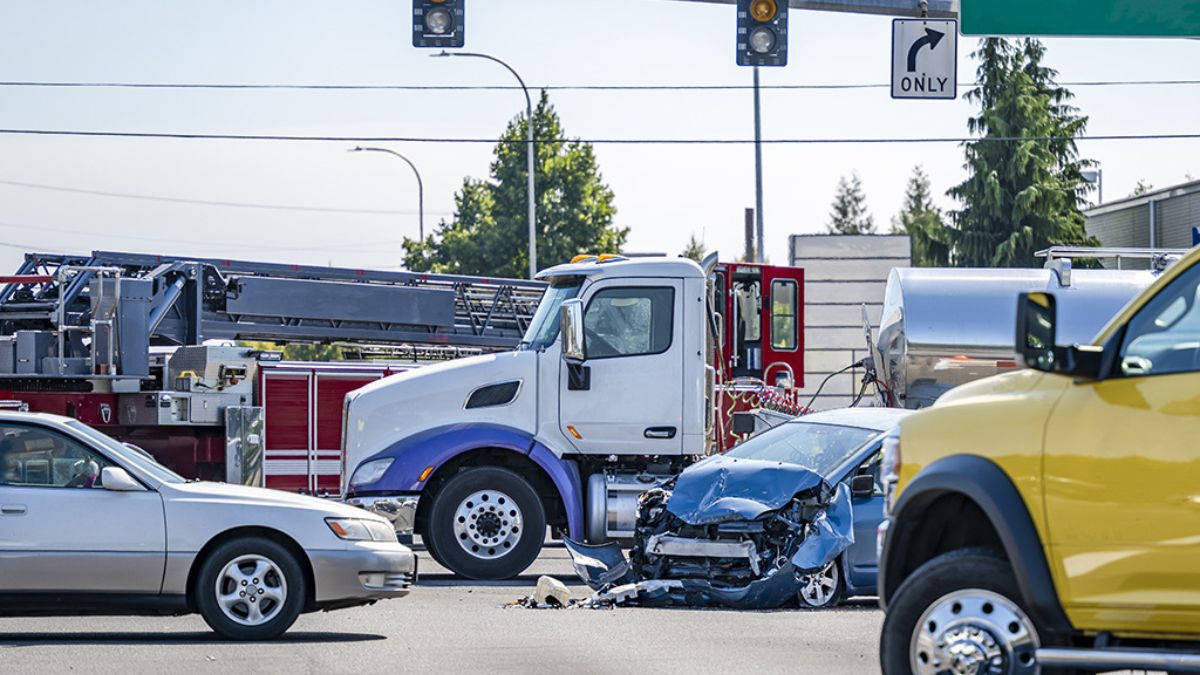LAW
The Legal Differences Between Car and Truck Accident Claims

When it comes to navigating the aftermath of a vehicle accident, not all cases are built the same. While both car and truck accidents may involve physical injuries, property damage, and insurance disputes, the legal landscape surrounding them differs significantly. From the scale of damages to the parties involved and the regulatory standards at play, truck accident claims bring complexities that most car accident cases do not. We will explore how these two types of cases differ in terms of legal responsibility, applicable laws, and the steps required for resolution, helping victims and their families understand what makes truck accident litigation more complex and demanding.
Key Legal Distinctions That Separate Car and Truck Accident Claims
Different Regulatory Oversight and Laws Apply
One of the most significant legal differences between car and truck accident claims lies in the regulatory framework governing each. Car accidents are primarily governed by state traffic laws, which address issues such as speeding, lane changes, and right-of-way rules. While truck accidents are also subject to these laws, they fall under an additional layer of federal oversight. Commercial trucks must comply with regulations from the Federal Motor Carrier Safety Administration (FMCSA), which include rules around driver qualifications, vehicle maintenance, hours-of-service limits, and drug and alcohol testing. For anyone involved in such complex cases, consulting a Summerville truck accident lawyer can be crucial, as this added layer introduces a new dimension of legal scrutiny that requires thorough understanding and experience.
For example, if a truck driver violated federal rules about rest breaks and fatigue contributed to the accident, that violation could significantly impact liability. Attorneys handling these cases often review driver logs, GPS data, and maintenance records to identify instances of non-compliance. Such regulations don’t apply to regular passenger vehicles, making car accident claims generally more straightforward in terms of legal boundaries.
Liability Often Involves Multiple Parties in Truck Accidents
Another major legal difference stems from who can be held responsible. In most car accidents, liability typically centers around one or two drivers involved in the crash. The focus is on determining negligence—whether someone failed to exercise reasonable care and caution. But in truck accident claims, the web of liability can extend far beyond just the driver. The trucking company, vehicle maintenance contractors, cargo loaders, and even manufacturers may all share fault.
For instance, if a trucking company forced its driver to meet unrealistic deadlines that encouraged speeding, or if the maintenance crew failed to properly service the brakes, then those parties can be legally accountable. This multi-party liability makes truck accident litigation more complex and time-consuming. Each entity involved may have its own insurance carrier and legal representation, making a single case a multifaceted battle of responsibility. Investigating these cases often requires a more detailed examination of employment records, contractual relationships, and corporate safety protocols.
Severity of Injuries and Damages Tends to Be Higher
Though both types of accidents can result in severe consequences, truck accidents usually involve more catastrophic injuries and higher financial stakes. A fully loaded commercial truck can weigh 20 to 30 times more than a standard passenger car. When such a vehicle collides with a smaller car, the physical impact is often devastating. This difference in scale not only affects the victims’ medical outcomes but also shapes the legal claims process. Truck accident victims may face lifelong disabilities, extended hospital stays, and loss of earning capacity—all of which must be accounted for in a legal claim.
As a result, the compensation sought in truck accident cases is usually significantly higher than that in car accident claims. Legal teams often collaborate with economists, medical professionals, and life care planners to quantify long-term losses. These added layers make truck accident claims not just emotionally heavier but legally more intricate when calculating just compensation.
Insurance Policies and Limits Vary Greatly
Insurance coverage is another area where car and truck accident claims diverge. Private individuals typically carry personal auto insurance with policy limits that might range from the legal minimums to higher optional coverage. In contrast, commercial trucking companies are required to carry significantly larger policies, often mandated by federal law.
These higher policy limits are intended to account for the potential for large-scale damage, but they also attract more aggressive defense tactics from insurance companies. The presence of more money at stake means more thorough investigations, more legal resources devoted to the case, and potentially more resistance to settling. For accident victims, this dynamic means that securing a fair outcome often requires a deeper understanding of commercial insurance law and negotiating tactics. Unlike a straightforward car insurance claim, a truck insurance case can become a drawn-out legal battle.
Understanding the legal differences between car and truck accident claims is essential for anyone involved in a serious collision. While both involve determining fault and seeking compensation, truck accident cases carry a heavier legal burden due to their complex regulatory framework, intricate liability chains, and significantly larger financial stakes. We have explored how federal oversight, evidence requirements, and the involvement of multiple responsible parties distinguish truck accident litigation. These cases demand more detailed investigations, stronger legal arguments, and an awareness of the broader legal landscape. For victims and their families, recognizing these distinctions can help them pursue justice with greater clarity and confidence.
LAW
How to Prove Financial Need in a Spousal Maintenance Claim

Facing the end of a relationship brings many challenges, especially when it comes to financial stability. In Australia, spousal maintenance provides financial support to a former partner who cannot adequately support themselves. But how do you actually prove you need this support? The key lies in presenting comprehensive evidence of your financial situation. Seeking spousal support legal advice early can significantly improve your chances of a successful claim.
Key Takeaways
- Spousal maintenance requires proving genuine financial need and your ex-partner’s capacity to pay
- Courts assess your income, expenses, assets, work capacity, and personal circumstances
- Comprehensive documentation including financial statements, bills, and medical reports forms the backbone of your claim
- Australian courts apply a two-part test: your inability to support yourself and your ex-partner’s ability to provide support
- Interim orders are available for urgent financial relief while your case progresses
Legal Framework for Spousal Maintenance
In Australia, spousal maintenance is governed by the Family Law Act 1975. This legislation applies to both married couples and de facto relationships. The family courts, including the Federal Circuit and Family Court of Australia, have jurisdiction to hear these matters.
When assessing claims, courts apply a two-part test: first, can the applicant support themselves adequately? Second, does the respondent have the capacity to provide financial support? Factors weighed include age, health, childcare responsibilities, income, assets, and relationship duration.
“Financial need isn’t just about proving hardship—it’s about demonstrating the gap between your reasonable needs and your current resources in a clear, documented way.” – Tonkin Legal
What Constitutes Financial Need
Financial need goes beyond simply wanting additional money. Courts look for evidence of reasonable living expenses that you cannot meet with your current resources. These typically include:
- Housing costs (rent/mortgage, rates, insurance)
- Utilities (electricity, gas, water, internet)
- Food and household necessities
- Healthcare expenses
- Transport costs
- Child-related expenses (beyond child support)
The court distinguishes between essential living costs and discretionary spending. They also consider whether your financial need is temporary (perhaps while you retrain for employment) or ongoing (due to age or disability).
Your other income sources, including child support, Centrelink payments, and part-time earnings, will be factored into the assessment of need.
Evidence Required for Your Claim
Proving financial need requires comprehensive documentation across several categories:
Income evidence: Gather recent payslips, tax returns from the past 2-3 years, PAYG summaries, and profit/loss statements if self-employed.
Bank records: Provide 12 months of statements for all accounts, credit card statements, and loan documents to show your complete financial position.
Expense documentation: Collect rent or mortgage statements, utility bills, medical invoices, school fee notices, and receipts for regular expenses.
Asset information: Include property valuations, share statements, superannuation details, and vehicle ownership papers.
Your personal circumstances also matter. Medical reports documenting health issues, evidence of caring responsibilities, or documentation showing time out of the workforce can strengthen your claim.
How Courts Calculate Financial Need
Courts typically assess your monthly income against your reasonable expenses to determine if there’s a shortfall. They consider net income (after tax) rather than gross figures.
Building a month-by-month budget that clearly shows your deficit is essential. This should account for shared expenses where relevant, and adjust for child support or other contributions you receive.
In contested cases, expert witnesses like forensic accountants, property valuers, or vocational assessors may be called upon to provide independent assessments of financial positions or earning capacity.
Applying for Interim Orders
If you face immediate financial hardship, you can apply for interim spousal maintenance while your main case progresses. Situations justifying urgent relief include having no income, facing eviction, or dealing with illness that prevents work.
For urgent applications, focus on preparing a concise affidavit outlining your immediate financial crisis, supported by recent bank statements and evidence of pressing expenses. Your application should present a clear financial summary that directly links to your supporting documents.
Effective Presentation of Your Case
The organisation of your evidence significantly impacts how the court perceives your claim. Create a numbered exhibit system with a table of contents for easy reference. Prepare a consolidated financial summary that highlights the gap between income and expenses.
Your affidavits should use plain language and refer directly to specific documentary exhibits. When records are incomplete, consider alternative evidence such as statutory declarations or third-party confirmations.
Avoid common pitfalls like hiding transactions, presenting inconsistent income information, or making unsupported expense claims. These can damage your credibility with the court.
Conclusion
Proving financial need for spousal maintenance requires methodical preparation and comprehensive documentation. Your evidence must demonstrate both your inability to support yourself adequately and your former partner’s capacity to provide assistance. The quality and organisation of your financial evidence often determine the outcome of your claim.
If you’re considering a spousal maintenance application, your next step should be to prepare a complete evidence bundle following the guidelines above. For personalised guidance tailored to your specific circumstances, Tonkin Legal can help you navigate the complexities of spousal maintenance claims and maximise your chances of success.
LAW
When can grandparents apply for visitation rights with their grandchildren?

The bond between grandparents and grandchildren is special and meaningful. However, family conflicts, divorce, or other circumstances can sometimes disrupt this important relationship. In Australia, grandparents concerned about maintaining contact with their grandchildren have legal options available. Pearsons Lawyers can assist grandparents in understanding their rights and the legal process involved in seeking visitation with their beloved grandchildren.
Key Takeaways
- Australian law recognises grandparents’ right to apply for contact with grandchildren under the Family Law Act
- Applications must prioritise the child’s best interests and demonstrate a meaningful relationship
- Mediation is typically required before court applications, with exceptions for urgent or safety matters
- State and territory regulations offer different pathways and resources for grandparents
- Alternatives to court proceedings include parenting plans and written agreements
Legal framework for grandparent visitation in Australia
The Family Law Act 1975 (Cth) provides the foundation for grandparent visitation rights in Australia. Unlike some countries, Australian law specifically mentions grandparents as people who may apply to the court for orders relating to children. This recognition acknowledges the valuable role grandparents often play in children’s lives.
Federal parenting orders are the primary mechanism for formalising grandparent contact arrangements. These orders can establish when and how grandparents may spend time with their grandchildren, communicate with them, or have input on significant decisions.
State and territory laws may supplement federal provisions, particularly regarding child protection matters. However, the Family Law Act remains the primary legislation for most grandparent applications.
Central to all decisions is the best interests of the child. Courts must prioritise this principle above all others, examining how grandparent contact would affect the child’s physical and emotional wellbeing, development, and family relationships.
Who can apply and eligibility criteria
The Family Law Act allows grandparents and other people concerned with a child’s care, welfare, or development to apply for parenting orders. While grandparents have explicit standing, they must demonstrate legitimate reasons for seeking formal visitation rights.
When assessing applications, courts consider several factors:
- The nature and history of the relationship between grandparent and grandchild
- Previous contact patterns and frequency
- The child’s specific needs and circumstances
- Parents’ views and reasons for objections (if any)
- Practical considerations for facilitating contact
- The child’s views, appropriate to their age and maturity
Applications may face limitations in situations involving family violence, active child protection interventions, or where there are genuine safety concerns. Courts carefully balance the potential benefits of grandparent contact against any risks to the child’s wellbeing.
“We often find that maintaining meaningful connections with grandparents provides children with a sense of family continuity and identity, particularly during times of family change or difficulty.” – Pearsons Lawyers
State and territory practical differences
While the Family Law Act applies nationally, practical processes and local resources vary across jurisdictions:
In New South Wales, grandparents can access specialised resources through Legal Aid NSW and the Law Society’s Solicitor Referral Service for family law matters.
Victoria offers grandparents support through the Victorian Legal Aid Grandparents Access Support Service and community legal centres specialising in family matters.
Queensland provides the Queensland Civil and Administrative Tribunal as an alternative forum for some family disputes, alongside traditional family court pathways.
Western Australia operates its own Family Court system, with slightly different procedures from other states, though the fundamental principles remain similar.
South Australia, Tasmania, the Australian Capital Territory, and the Northern Territory each maintain jurisdiction-specific resources and support services for grandparents, while following the national Family Law Act framework.
Step-by-step application process
Before court proceedings, most grandparents must attempt family dispute resolution (FDR). This mediation process aims to resolve issues without litigation. A certificate from an accredited FDR practitioner is typically required before filing court applications, though exceptions exist for urgent matters or where FDR is inappropriate.
If mediation doesn’t resolve the matter, grandparents can prepare and file an application for parenting orders with the Federal Circuit and Family Court of Australia. This involves completing specific forms detailing the orders sought and the circumstances.
Evidence preparation is critical. Grandparents should gather relevant documentation showing their relationship with the grandchild, previous care arrangements, and any relevant communications. This evidence is presented through affidavits and supporting documents.
The court process typically involves several stages: initial hearings to clarify issues, possible interim orders while the case proceeds, and eventually a final hearing if the matter doesn’t settle. This process commonly takes 12-18 months and can cost several thousand dollars, depending on complexity and whether legal representation is engaged.
Alternatives to court and contact arrangements
Many grandparents find success with less formal approaches. Parenting plans—written agreements between family members—can establish contact arrangements without court involvement. While not legally enforceable like court orders, they provide a framework for cooperation.
For situations requiring additional support, supervised contact programs through community organisations can provide neutral spaces for visits. These programs often include professional supervision and can help rebuild relationships gradually.
Valuable referral sources include community legal centres, family relationship centres, and seniors’ advocacy groups. These organisations can provide guidance, emotional support, and practical assistance throughout the process.
Practical tips for grandparents
Documentation strengthens any application. Grandparents should maintain records of their involvement in grandchildren’s lives, including photos, messages, school involvement, and gift-giving. These materials help demonstrate the nature and value of the relationship.
Communication approach matters tremendously. When discussing contact with parents, grandparents should remain respectful, child-focused, and solution-oriented. Acknowledging parents’ authority while emphasising the benefits to children often proves more effective than confrontational approaches.
Seeking legal advice early can prevent common pitfalls. Many grandparents can access initial consultations at reduced rates through senior legal services, community legal centres, or pro bono schemes.
Situations where applications are unlikely to succeed
Courts may be reluctant to grant orders when there has been minimal previous contact or relationship between grandparent and grandchild. Building a case is challenging without demonstrating an established bond.
Applications face significant hurdles when legitimate safety concerns exist, particularly with substantiated allegations of abuse, domestic violence, or substance issues that could affect the child.
Courts also consider parents’ objections carefully, especially when they appear reasonable and child-focused rather than punitive or retaliatory. Parents’ views carry substantial weight, though they aren’t automatically decisive.
Frequently asked questions
Yes, grandparents can apply even when parents object or refuse cooperation. However, these cases often require stronger evidence and may benefit from legal representation. Courts can enforce orders if necessary, though cooperative solutions generally benefit children more.
While grandparents typically seek contact orders, they can apply for parental responsibility in exceptional circumstances where parents are unable to fulfil their roles due to incapacity, abandonment, or serious welfare concerns. These applications face higher thresholds and closer scrutiny.
Court timeframes vary widely, from several months to over a year, depending on court resources, case complexity, and whether interim arrangements are needed. Costs range from several hundred dollars for self-represented applications to many thousands with full legal representation.
Children’s views are considered based on age, maturity, and understanding. While not determinative, their perspectives gain increasing weight as they mature. Courts may appoint independent children’s lawyers or family consultants to help ascertain and represent children’s views appropriately.
The court process concludes with a final hearing where all evidence is presented and a judge makes determinations based on the child’s best interests. Orders typically specify contact frequency, duration, and logistics.
Conclusion
Grandparents seeking visitation rights have recognised legal pathways in Australia, though success requires careful preparation and a clear focus on children’s best interests. Before pursuing court action, exploring mediation and informal agreements often produces better outcomes for all involved. Each situation is unique, and outcomes depend heavily on specific family circumstances and the quality of relationships involved. For personalised guidance tailored to your situation, Pearsons Lawyers can provide the expertise and support needed to navigate this emotional and complex area of family law.
LAW
What Happens If Both Drivers Are at Fault in an NYC Car Accident?

When a car accident occurs, you would think that determining who is to blame is relatively straightforward. However, accidents aren’t always so clear-cut, and it is quite possible for both drivers to share some level of blame for the accident. Suppose both parties are at fault; how does the law deal with these situations, and most importantly, can the drivers involved still recover compensation? In this blog, the team at Alex Yadgarov & Associates will be lending their expertise as the best car accident lawyers in NYC to answer these questions and help better protect your rights to fair compensation after a collision.
How do we claim compensation through insurance for a NYC car accident?
In New York, if you are looking to claim compensation after a car accident, you need to contact the insurance company. The law in New York requires all drivers to have the appropriate liability coverage. If an accident occurs and causes damage to property and injuries to persons, any compensation owed to them will be paid out by your liability insurance. The liability insurance covers $10,000 in property damage per accident, $25,000 for bodily injury per person, $50,000 for bodily injury per accident, and $50,000 for death per accident.
If the crash resulted in injuries, the injured can also call on their Personal Injury Protection (PIP) insurance (i.e., no-fault insurance) to cover medical expenses, around 80% of lost wages, and other relevant expenses. The injured can claim up to $50,000 through PIP insurance. Since New York is a no-fault state, bearing the fault for the accident does not prevent you from claiming insurance. This means that even the driver responsible for the accident can claim compensation from their insurance.
In a situation where you’ve been injured by an uninsured motorist and your expenses exceed the PIP threshold, you can cover the additional expenses through your uninsured motorist coverage. Even non-economic damages, such as pain and suffering and mental distress, which PIP coverage does not cover, are also eligible for claims.
How does fault impact compensation?
When an accident happens and both parties share the blame for it, it becomes a matter of comparative fault. Simply put, if you are found to be partially at fault for the accident, the compensation you receive for your damages and injuries will be reduced to reflect the extent of your fault. Comparative fault in New York is considered under the pure comparative negligence rule.
For example, consider a car accident at an intersection involving individuals A and B. Both A and B have suffered damages and injuries and are claiming $50,000 as compensation. The accident report for the incident reveals that when the accident occurred, A was running a red light and B was texting while driving, and it puts 50% of the blame on A and 50% on B. Since both parties are at fault for the accident, their compensation will be reduced on the basis of pure comparative negligence. This means that both A and B will have their compensation reduced by 50%, only allowing them to claim $25,000.
Can you still claim compensation if you are mostly to blame for the accident?
In the previous example, both parties shared equal blame for the accident—but what would happen if one party were more to blame than the other? Fortunately, in New York, you are still able to claim compensation for damages and injuries, even if you are mostly to blame for an accident.
Since PIP insurance is no-fault, you can call your insurance to cover any medical expenses, lost income, and other related expenses. At the same time, since New York has adopted pure comparative negligence as opposed to modified comparative negligence, you can still claim compensation even if you are mostly responsible for the accident, albeit a significantly lower amount. If it was modified comparative negligence, you would not be allowed to claim compensation if your fault was more than 50%.
Conclusion
When the time comes to determine who is at fault for a car accident in NYC, things can get a bit complicated, especially when both the parties involved in the accident are partially to blame. In the event of such an accident, you need strong legal representation from an experienced car accident lawyer in NYC to build your case, protect your rights, and secure proper compensation.
If you are looking for such representation, Alex Yadgarov & Associates is here to help. Over the years, our team has represented many New Yorkers and helped them achieve proper compensation for their car accident injuries. Get in touch with us, schedule a free consultation, tell us your story, and focus on your recovery. Let us take care of the rest and get you the compensation you deserve.
-

 TECHNOLOGY5 months ago
TECHNOLOGY5 months agoTop 10 Must-Read Stories from Kristen Archives You Can’t Miss
-

 TECHNOLOGY11 months ago
TECHNOLOGY11 months agoSky Bri Net Worth Revealed: How She Built Her Financial Empire
-

 TOPIC1 year ago
TOPIC1 year agoBasement Renovation Contractors: How They Tackle Structural Issues During Renovations
-

 TOPIC7 months ago
TOPIC7 months ago5 Reasons the //Vital-Mag.Net Blog Dominates Lifestyle
-

 TOPIC6 months ago
TOPIC6 months agoTop 10 Articles from the ://Vital-Mag.net Blog That You Can’t Miss
-

 CRYPTO9 months ago
CRYPTO9 months agoCrypto30x.com Review: Is It the Right Platform for You?
-

 BUSINESS5 months ago
BUSINESS5 months agoTraceLoans Explained What You Need to Know
-

 ENTERTAINMENT3 months ago
ENTERTAINMENT3 months agoNHentai.NEF: Navigating the Popular Hentai Archive with Ease
